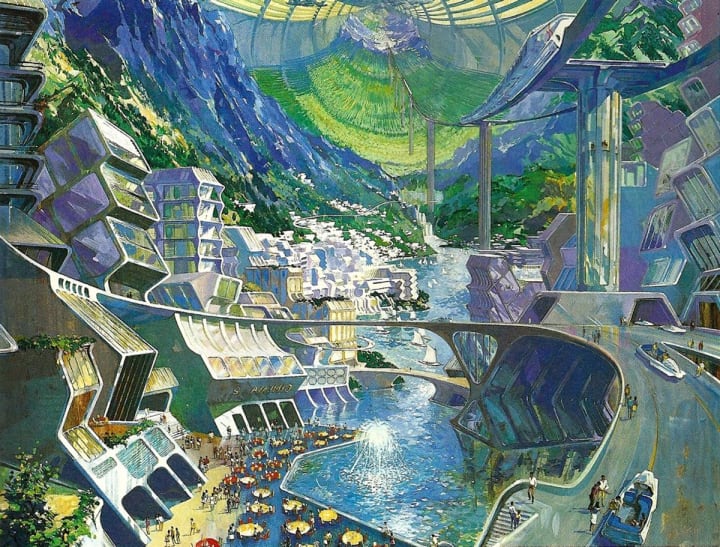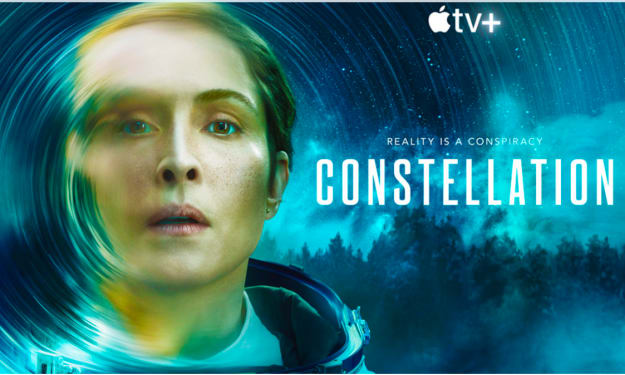Space colonization is an iconic and enduring facet of fantastic literature. Driven by expectation, bold prediction, and unrestrained post-industrial optimism, the notion was addressed by scientists as early as 1903, and as is often the case in the history of science. Further exploration of the concept was spearheaded by the imaginations of countless science fiction authors—and brought to life by pulp illustrators.
Initial imaginations of life in space evolved alongside physicists' real-world proposals, and, at least for a short time, became carefully-constructed paradigms before becoming outdated. Pulp artists, like Frank R. Paul, paved the way throughout the 1930s for both future-thinkers and other illustrators with his Life On... and A City On... series of paintings, which depicted visits to each planet in our solar system, complete with native life forms and their dwellings.
Future of Human Habitation

Image via Tumblr
The central question when artists consider human space colonization, however, is, "How will cities look?" The city, after all, is regarded as the crowning achievement of advanced society. As pervasive a subject as robotics and space-flight, the city of the future—orbital, lunar or extraterrestrial—is a chief ornament of fantastic writing. As a beacon of scientific expectation, it has captivated writers, artists, and their audiences for decades.
In the lexicon of science fiction, urban archetypes were quickly established, and tend to be universally recognized. For one, the Cyclopean megalopolis: the concept of a future city taken to extremes, with massive interconnected towers built as tall as imagination allows, covered by a transparent dome, unified, fully automated, replete with landing pads, raised roadways accompanied by frantic aerial traffic, and a gadget-laden populace, whose only pursuit is leisure. In the early 20th century, all signs pointed to such epic arcology as the apex of urban engineering.
These megacities, however, despite their Utopian trappings, were frequently nightmarish under the dome. Science-fiction illustrators, seeking to assert themselves in the developing pulp era, often created more optimistic visions than their literary counterparts. While they might be breathtaking to look at, unending vistas of ivory towers and enforced good behavior can become hell in print, especially at ground level, where squalor is masked by architectural grandeur.
More whimsical approaches of imagining the urban environment in space—such as the floating city—briefly flourished, particularly in the melodramatic sub-genre of space opera. However, as the dawn of the real Space Age approached, science fiction grew in complexity, seeking credibility after almost 50 years of bug-eyed monsters, spacekinis, and hover cars. The primary archetype of the urban Utopia was discarded, and left in the Pulp Era. Realism eventually crept in, and science fiction bid adieu to its fanciful perceptions. Instead, authors and illustrators sought to observe the scientifically accurate Hard science fiction and the more experimental New Wave.
A contemporary motif in post-pulp science fiction is the city as oppressive tool: the Elysium model of an unobtainable home set amongst the stars, safe from the remnants of humanity still stranded on a ravaged, depleted (or irradiated) planet. An organizational hierarchy that begins in space and ends on Earth, or vice versa.
Though he is best known for his influential paintings of gigantic spacecrafts, Chris Foss' illustrations take the size and scope of the future city to extremes. The product of witnessing a post-war, post-industrial Britain, Foss' work integrates the railway sidings and shipyards of his everyday experience with the excitement of space travel. The result is monolithic architecture, high-tech hardware, and vast and symmetrical landscapes, which rarely allow inhabitants to be observed as anything more than specks.
This is no brave new world. Foss' depiction of technological advancement belies a pessimism and a sense of emptiness: a home on other worlds can just as well be a crumpled shipwreck or barren asteroid. His colonies are industrial, their surroundings desolate and barren.
If there is a commentary here, it's that mankind has become of secondary importance to its machinery. If we do occupy other worlds, it will be uncomfortable, defined by engineering and the drudgery of mechanized labor. Foss' approach birthed an entire school of imitators confident in the rationale that space architecture did not require the soft, round edges of the past. The galaxy of science-fiction illustration grew littered with unrecognizable, incongruous shapes. They are lived in, but the leisure is gone.
Sci-Fi Cities Inspire the Future

Image via Tumblr
In this respect, the Okie cities in James Blish's Cities In Flight novels are an antecedent: destitute cities from an Earth gripped by economic depression made spaceworthy by anti-gravity devices informally referred to as, spindizzies, roam the galaxy as nomadic, migratory habitats. Many artists have tackled the subject since the books' original publication in 1956, but few suggest such massive scale as John Harris' expressive renderings.
A focal point of artwork, based on emergent technologies and concepts can be found in the portfolio of Robert T. McCall (1919-2010), whose sensibilities after the moon landing reinforced the notion that space colonization was no longer a visionary proposition. A key contributor to NASA's art program, his portfolio ranges from work for science fiction cinema—with promotional and production artwork for 2001: A Space Odyssey, Star Trek: The Motion Picture and Walt Disney studios' Black Hole—to explorations on the possibilities of future space programs, illustrating the Space Age for numerous aerospace publications.
Painting an Optimistic Future

Image via Tumblr
A singular talent, his approach favored conceptual authenticity, utilizing designs defined by application, and followed contemporary concepts such as physicist Gerard K. O'Neill's cylindrical Island Three, and the now ubiquitous torus-shaped space stations that have been considered and developed since the beginning of the 20th century.
Consistently authoritative, and preserving a sense of optimism, his iconic renderings suggest a treatise that mankind's first step on the moon was the inauguration of our fledgeling emancipation from Earth and eventual residence in outer space. The more fanciful notions of the past are absent—though he would revisit the idea of a floating city as theories on anti-gravity were deemed feasible and given serious consideration. To a fault, he gives prominence to utilitarian, scientific, and exploratory application.
Science and science fiction walk hand-in-hand, both borrowing liberally from each other. Space colonization is no exception. The theories and real-world applications hypothesized by engineers, rocket scientists and physicists maintain that the concept is a technical possibility; today the space station, at least, is not beyond mankind's technical capability. The reality of an autonomous city in space may still be one for the eggheads to determine, but—buoyed by the illustrators who color the world—we can always dream.
About the Creator
Jeff Love
I can't define a robot, but I know one when I see one.






Comments
There are no comments for this story
Be the first to respond and start the conversation.